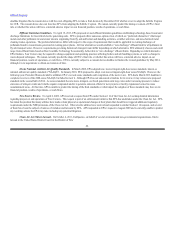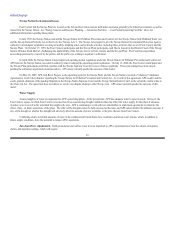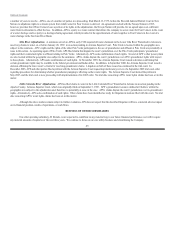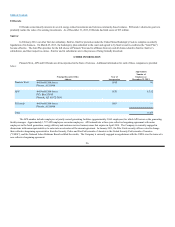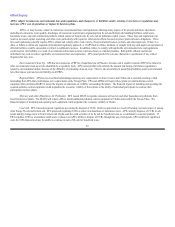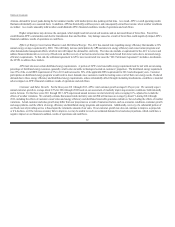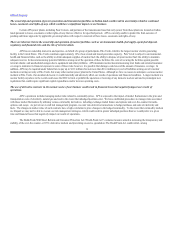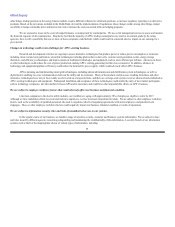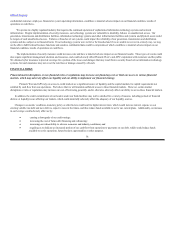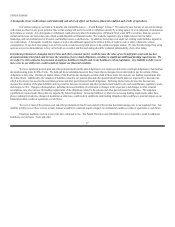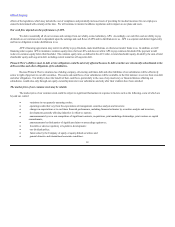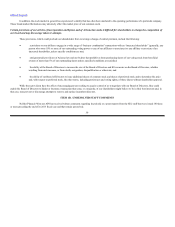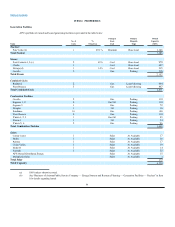APS 2013 Annual Report Download - page 34
Download and view the complete annual report
Please find page 34 of the 2013 APS annual report below. You can navigate through the pages in the report by either clicking on the pages listed below, or by using the keyword search tool below to find specific information within the annual report.
Table of Contents
GHGs. This legislation, regulations and other state-specific initiatives may affect APS’s business, including sales into the impacted states.
Physical and Operational Risks. Weather extremes such as drought and high temperature variations are common occurrences in the Southwest’s
desert area, and these are risks that APS considers in the normal course of business in the engineering and construction of its electric system. Large increases
in ambient temperatures could require evaluation of certain materials used within its system and represent a greater challenge.
Deregulation or restructuring of the electric industry may result in increased competition, which could have a significant adverse impact on APS’s
business and its results of operations.
In 1999, the ACC approved rules for the introduction of retail electric competition in Arizona. Retail competition could have a significant adverse
financial impact on APS due to an impairment of assets, a loss of retail customers, lower profit margins or increased costs of capital. Although some very
limited retail competition existed in APS’s service area in 1999 and 2000, there are currently no active retail competitors offering unbundled energy or other
utility services to APS’s customers. On May 9, 2013, the ACC voted to re-examine the facilitation of a deregulated retail electric market in Arizona. The ACC
subsequently opened a docket for this matter and received comments from a number of interested parties on the considerations involved in establishing retail
electric deregulation in the state. One of these considerations is whether various aspects of a deregulated market, including setting utility rates on a “market”
basis, would be consistent with the requirements of the Arizona Constitution. On September 11, 2013, after receiving legal advice from the ACC staff, the
ACC voted 4-1 to close the current docket and await full Arizona Constitutional authority before any further examination of this matter. The motion approved
by the ACC also included opening one or more new dockets in the future to explore options to offer more rate choices to customers and innovative changes
within the existing cost-of-service regulatory model that could include elements of competition. One of these options could be a continuation or expansion of
APS’s existing AG (Alternative Generation) — 1 program, which essentially allows up to 200 MW of cumulative load to be served via a buy-through
arrangement with competitive suppliers of generation. We cannot predict future regulatory or legislative action that might result in increased competition.
In 2010, the ACC issued a decision holding that solar vendors that install and operate solar facilities for non-profit schools and governments
pursuant to a specific type of contract that calculates payments based on the energy produced are not “public service corporations” under the Arizona
Constitution, and are therefore not regulated by the ACC. A second matter is pending with the ACC to determine whether that ruling should extend to solar
providers who serve a broader customer base under the same business model. The use of such products by customers within our territory would result in
some level of competition. APS cannot predict whether the ACC will deem these vendors “public service corporations” subject to ACC regulation and when,
and the extent to which, additional service providers will enter APS’s service territory, increasing the level of competition in the market.
OPERATIONAL RISKS
APS’s results of operations can be adversely affected by various factors impacting demand for electricity.
Weather Conditions. Weather conditions directly influence the demand for electricity and affect the price of energy commodities. Electric power
demand is generally a seasonal business. In
31



